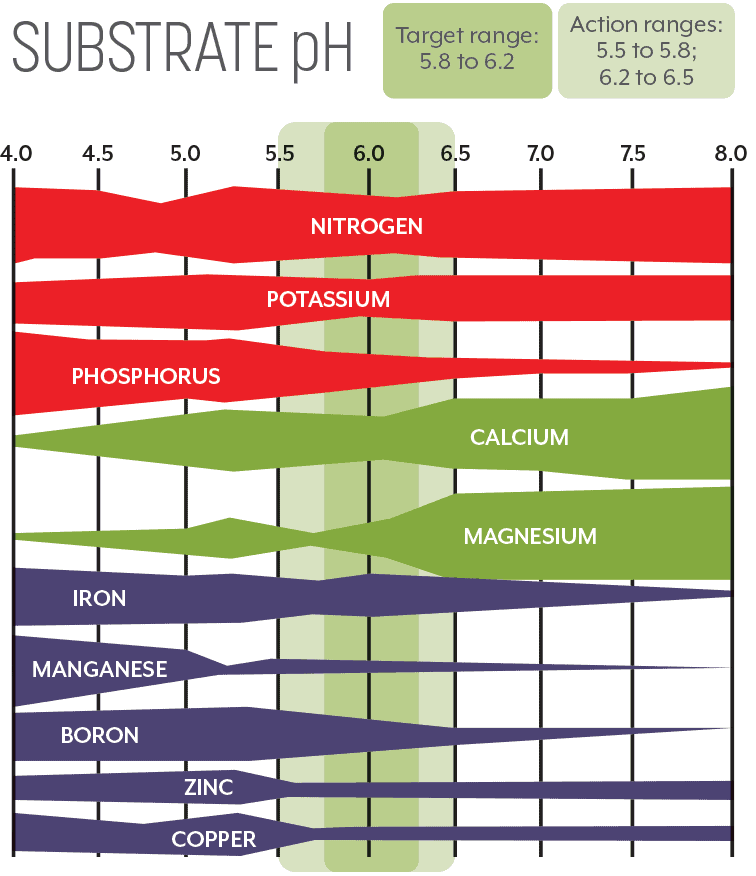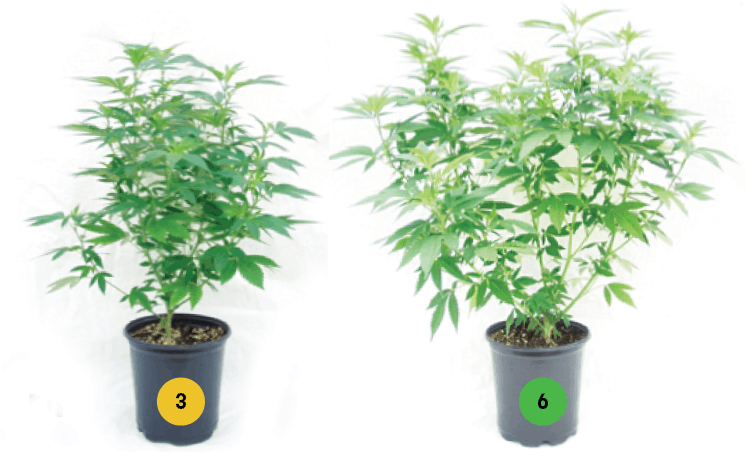
grandriver | iStockPhoto

A recurring series focusing on plant cultivation by university researchers
One of the primary goals for cannabis cultivators is to optimize plant growth for stronger, healthier yields. To optimize plant growth, monitoring and managing nutrient levels is essential; however, numerous factors can affect nutrient availability and uptake for cannabis plants. As growers know, cultivation is a balancing act of providing adequate nutrient levels in proper ratios, and, most importantly, ensuring that the substrate pH is within the recommended range. Each of these factors properly applied together optimize plant growth, but if one factor is out of balance, the plant will suffer.
Nutrient “lockup” or “lockout” is when a particular nutrient is unavailable for the plant to uptake. This is usually caused by an elevated substrate pH, a situation that has plagued cannabis growers for many years. A second problem is improperly balanced nutrient levels. This is referred to as an antagonism. In addition, one must ensure that adequate levels of fertility are provided. While these can all limit nutrient availability, their fundamental causes are different. And perhaps the most important factor is substrate pH.

Tip #1: Find The pH Sweet Spot and Avoid Nutrient Lockout
Substrate pH is important to plant nutrition, as it directly impacts plant nutrient availability (Fig. 1, above). Some nutrients become more available, while others become unavailable depending on the substrate pH level. Nutrient lockout can be avoided by maintaining the recommended substrate pH for cannabis, between 5.8 to 6.2. This target range is based on research trials conducted at North Carolina State University. Levels below and above that range should be viewed as marginal zones in which corrective measures should be taken to avoid nutritional problems. Levels below pH 5.5 or higher than 6.5 can lead to an array of nutritional issues, which includes nutrient lockout.

Low pH
When substrate pH levels fall below 5.5, micronutrient availability increases. Substrate micronutrients (boron (B), copper (Cu), iron (Fe), manganese (Mn) and zinc (Zn)) become more readily available when the substrate pH becomes too acidic (see the wider bands in Fig. 1), with the exception of molybdenum (Mo). The most prominent problems observed in greenhouse production occur with Fe and Mn toxicity.
A low substrate pH can also hinder both Ca and Mg availability, but usually fertilization programs provide adequate levels of those elements, preventing deficiencies even if the substrate pH is low.
Symptoms of Fe and/or Mn toxicity may appear as bronzing on older leaves. However, in experiments conducted at North Carolina State University, we did not observe symptomology of lower leaf blackening or bronzing with cannabis plants, only stunted growth (Fig. 2, above). These results suggest that given normal levels of micronutrients in the fertilizer solution, cannabis can adequately regulate micronutrient uptake under low substrate pH conditions and avoid leaf symptomology. However, in a follow-up research study, we found if excessive micronutrients were supplied, lower leaf bronzing does occur. Therefore, it is important to provide adequate, but not excessive, micronutrient levels to cannabis to help prevent toxicity symptomology development in case the substrate pH dips too low.

High pH
When the substrate pH is elevated, cannabis can develop interveinal chlorosis (yellowing) on the youngest leaves (Fig. 3, above). This is a common situation that occurs with many greenhouse-grown species, such as petunias, when the increased substrate pH makes micronutrients such as Fe unavailable to the plant. This symptomology or lockout can occur even if adequate Fe levels are being provided in the fertilizer. While deficiencies of other micronutrients such as B, Cu, Mn and Zn also can occur, problems of Fe lockout are most commonly observed.
The good news is that micronutrient toxicities and lockout can be avoided by monitoring and managing the substrate pH. (Read “How to Establish a Cannabis Nutrient Monitoring Program” for more guidelines.)

Tip #2: Ensure the Proper Ratios to Prevent Tie-Up
Providing plants the proper nutrient balance also will help avoid induced deficiencies. Excessive levels of one element will cause an antagonism against the others, or a tie-up of nutrients (Table 1, above). In severe cases, plants will develop nutritional deficiencies. In this case, too much of a good thing is bad.
For instance, excessive potassium (K) will most commonly result in either calcium (Ca) deficiency or magnesium (Mg) deficiency symptoms. Many instances of Mg deficiency in cannabis may be due to excessive K or Ca being supplied and not because of the lack of available Mg to the plant. Abnormally high levels of one element normally does not result in toxicity symptoms. For cannabis, K, Ca, and Mg all appear to be needed in larger quantities compared to other greenhouse floriculture species. In general, the rule is to provide K, Ca and Mg in a 4:2:1 ratio to avoid antagonisms. For commercial cannabis production, we recommend a similar ratio of about 200 ppm K to 100 ppm Ca to 50 ppm Mg.
Managing microelements also can be challenging. The margin of error between deficient and excessive concentration rates is very narrow. Until you become comfortable mixing your own micronutrient fertilizer salts, it’s safer to rely on premixed micronutrients or the micros provided in commercial fertilizer blends. This will help avoid micronutrient tie-ups.
Providing the essential elements at the right balance is the key to optimizing plant growth.

Tip #3: Optimize Nutrient Levels to Prevent Nutrient Disorders
The final step in preventing and diagnosing nutrient lockup is ensuring that your fertilization program is providing adequate nutrient levels to the plants. Optimizing fertility management is a strategy of supplying the appropriate level of both the micronutrients and macronutrients to cannabis to meet the demands for plant growth. If the supply is too low, then plant growth is hindered because of nutrient deficiency (Figs. 4 & 5), and the plant will produce fewer and/or smaller flower buds.
Elevated fertilizer levels can lead to excessive leaf and shoot development at the expense of flower growth. Excessively high levels of fertilizer in the substrate also can lead to stunted growth, leaf necrosis and nutrient imbalances (Fig. 6). The good news is that conducting in-house nutrient monitoring by measuring the electrical conductivity (EC) levels will enable you to avoid this situation and ensure your cannabis crop is on track. (For additional details, read Cannabis Business Times articles “Optimizing Electrical Conductivity" and “Troubleshoot Nutrient Problems Before They Occur.”)
Conclusion
Providing adequate fertility, balancing the nutrient ratios, and managing the substrate pH will go a long way in avoiding deficiencies, nutrient tie-up and nutrient lockout, leading to better growth and ideal yields.
Dr. Brian E. Whipker is a professor of floriculture at North Carolina State University specializing in plant nutrition, plant growth regulators and diagnostics. During the past two years, he co-authored eight scientific journal articles on the impact of fertilization with greenhouse species and three disorder diagnostic guides. Dr. Whipker has more than 28 years of greenhouse experience working with growers.
Paul Cockson is a graduate research and teaching assistant at North Carolina State University. He has a degree in plant and soil sciences with a concentration in agroecology. For the past few years, he has worked in the plant nutrition lab at NCSU with Dr. Brian Whipker.
Patrick Veazie is an undergraduate researcher at North Carolina State University.
David Logan is an undergraduate research assistant at North Carolina State University.
Dylan Kydd is an undergraduate research assistant at North Carolina State University.
Dr. W. Garrett Owen is an assistant professor and extension specialist of floriculture, greenhouse, and controlled-environment crop production in the Department of Horticulture at the University of Kentucky.

Explore the January 2021 Issue
Check out more from this issue and find your next story to read.
Latest from Cannabis Business Times
- Navigating Cultivation Room Design: Optimization vs. Maximization
- Verano Opens 18th Medical Cannabis Dispensary in Pennsylvania
- Hundreds Interested in Kentucky’s Medical Cannabis Licenses; Just 17 Apply So Far
- Aurora Receives Expanded Cultivation, Unique Research Licenses for German Facility
- Curaleaf Opening 2 New York Medical Dispensaries, Launching Adult-Use Sales at 2 Other Stores
- Ohio’s Adult-Use Licensing Process Leads CBT’s Top Stories in July
- Planet 13 Launches Lifestyles Brand Company; Signs 1st Sponsored Athlete in UFC Title Contender Chito Vera
- LeafLink Acquires Leading Cannabis Banking Platform Dama Financial





